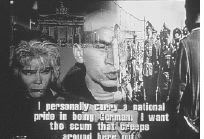The Pixel Imperfect
The Bay Area's photographers try to refocus the lens of 'truth'
By Ann Elliott Sherman
THE NOTION that there is no monolithic "photographic truth" to be objectively captured by the lens is scarcely new. The purity of the absolute moment has long been diluted by dramatically posed "candid" shots, darkroom tricks and other interventions in staging reality. With the ascendancy of digital photography, the ease with which images can be altered has made computer-generated sleight of hand a staple in our media diet.
All of which makes the artist's task of rousing our lulled imagination ever more difficult. Pixel Perfect, a survey of Bay Area digital photography presented at the San Jose Museum of Art in conjunction with Metamorphoses: Photography in the Electronic Age, stimulating and enervating by turns, has the resulting counteractive impact of an Irish coffee.
Much of the intentionally pointed commentary makes the cutting edge seem rather dull. Keith Cottingham's Fictitious Portraits of nonexistent twins and triplets assembled and cloned from scanned images play like a clever parlor game rather than effectively evoking the cultural specter the process implies.
Rebeca Bollinger's ponderings about the quality of information filtered through technology and the resulting third-hand image employs a process that sounds more interesting than the out-the-front-door traffic report looks. And Wayne Smith's mistrust of the eye-candy appeal of the vivid colors in Iris ink-jet prints similarly results in minimalist abstracts that lean heavily on their accompanying descriptions of process for their impact.
Borrowing heavily from the agitprop graphic canon of appropriated talking heads layered on top of historical documentary shots, Paul Klein's The Politics of Memory in Germany and France may have its heart in the right place, but extending the déjà vu to such stale visual strategy produces a jaded, rather than inspired, response.
Similarly, familiarity drains the impact of Chip Lord's studies in contrasts, the Awakening From the 20th Century series. The diptychs pair present-day photos of Silicon Valley corporate headquarters with dystopian digital montages of densely populated street scenes and images copped from Blade Runner. The latter are arguably valid pop-culture referents functioning as efficient shorthand for a particular vision of the future, but one person's appropriation is another's easy way out. If Lord wants viewers to question our treatment of public space, he should work harder to avoid a visual cliché.
Robin Lasser, for one, does just that. Tweaking the landscaping kitsch of planting flowers to form words on a hillside, Lasser's computer-wrought proposal for an upcoming installation turns commuters' view of an East Bay refinery into a wry hybrid of ecological commentary and vanity-plate humor in PRECarIOUS and CHANGING HABITat. Her photographs put the thought-provoking comments smack dab in the big picture, visually making the connections between the increasingly auto-dependent American Dream and all of its demands on our resources.
IRONICALLY, some of the most unabashedly lyrical works put the technology to its most compelling use. Stephen Johnson's The Digital National Parks Project, for instance, is the artist's bid to become a computerized Ansel Adams.
In the Hide and Seek series, Diane Fenster pulls us into a virtuosic reverie on identity, gender and mystery that she calls "an archeological excavation of memory."
Known for her evocative marriage of image and text, Fenster uses lines from Chilean poet Vicente Huidobro as a springboard for a fractured near-repetition of written and visual imagery. Taking advantage of the digital medium's conduciveness to surrealist montage, scanned Polaroid transfer photos are broken up and combined into uneven grids suggesting windows. Images of sleeping bodies, hands, bedroom lamps or furniture meld with cut-up text, sometimes appearing scratched into the emulsion or floating in a positive or negative rendition of a serif typeface.
The grainy texture of the ink-jet print combines with parchment tones rendered agate-like through the judicious use of vivid color for a dreamy, through-the-glass look. In concert with the echoed and scrambled refrains, Fenster's variations on Huidobro's cantos are an apt mimesis of the porous membrane between memory and imagination. What's more, instead of reminding one of an ad or CD cover, they connect instead with earlier work in the artist's idiosyncratic oeuvre.
[ Metro | Metroactive Central | Archives ]
This page was designed and created by the Boulevards team.

It's All the Past Now # 5: Text and image are digitally combined in the work of Paul Klein.
Pixel Perfect: Digital Photography in the Bay Area runs through Nov. 10 at the San Jose Museum of Art, 110 S. Market St. (408/294-2787)
From the September 12-18, 1996 issue of Metro
Copyright © 1996 Metro Publishing, Inc.
![[Metroactive Arts]](/arts/gifs/art.gif)